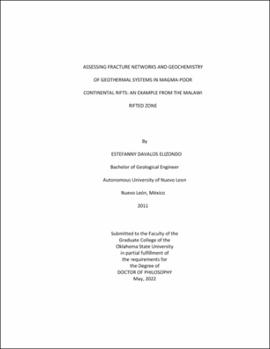| dc.contributor.advisor | Laó Dávila, Daniel A. | |
| dc.contributor.author | Davalos Elizondo, Estefanny | |
| dc.date.accessioned | 2023-03-31T19:15:01Z | |
| dc.date.available | 2023-03-31T19:15:01Z | |
| dc.date.issued | 2022-05 | |
| dc.identifier.uri | https://hdl.handle.net/11244/337188 | |
| dc.description.abstract | This doctoral dissertation investigates structurally controlled geothermal systems of poor-magma continental rifts in the Western Branch, using as an example the Malawi Rifted Zone (MRZ). The MRZ is at the southern end of the Western Branch of the East African Rift System. It has been affected by repeated stages of deformation, a Paleozoic- Mesozoic rifting event, and the current Cenozoic rifting, which are superimposed on Paleoproterozoic shear zones of mobile belts. Thereby, the propagation and segmentation of the present-day Cenozoic rifting have been controlled by inherited Precambrian suture zones and Mesozoic rift basins structures. The high heat flow and hot springs reported in some segments of the ~N-S Cenozoic rift are the main evidence of the role these structures play in the geothermal systems in this region. The research aims to advance the understanding of structurally controlled geothermal systems to help accelerate the development of low- to medium-temperature geothermal resources in the Western Branch countries. To this end, this research investigates the geochemistry of hot springs and the distribution of estimated reservoir temperatures, the fracture network architecture, and its reactivation potential to identify favorable settings and structures that control the geothermal fluids pathways and storage of geothermal systems. A combination of geochemistry, remote sensing, structural geology, and geophysical methods was implemented to address the objectives of this dissertation. The main results of this research are summarized as follows: (1) the hot springs in the MRZ have their origin in the local meteoric water, infiltrated at depth, and then heated by a high heat flow, where water-rock interaction takes place. Afterward, the parent water ascends through faults to the surface, and processes such as admixture with cold water (>45%) and CO2 outgassing occur. (2) The northern part of the MRZ shows the hottest area with a maximum reservoir temperature estimated at ~200 °C by geothermometers in the Chiweta zone. (3) Favorable structures control the ascent of geothermal fluids in the northern part of the rift showing high fracture intensity and connectivity proxies a) fault segments coalescing to form hard and soft-linked relays, b) two different oriented fracture segments intersecting each other, and c) on the tips of major normal faults. (4) Aeromagnetic data revealed that possible reactivated foliation planes of Precambrian Shear Zones are important structural controls of geothermal waters at greater depths. (5) A high reactivation potential of ~NW- and ~NNE-striking faults southwest- and northwest dipping respectively, were identified as active fluid pathways in the Chiweta zone. (6) The reactivation potential results allowed defining possible structural boundaries of the Chiweta reservoir and improved its geothermal conceptual model. Detailed information about this doctoral dissertation is presented in the following chapters. | |
| dc.format | application/pdf | |
| dc.language | en_US | |
| dc.rights | Copyright is held by the author who has granted the Oklahoma State University Library the non-exclusive right to share this material in its institutional repository. Contact Digital Library Services at lib-dls@okstate.edu or 405-744-9161 for the permission policy on the use, reproduction or distribution of this material. | |
| dc.title | Assessing fracture networks and geochemistry of geothermal systems in magma-poor continental rifts: An example from the Malawi Rifted Zone | |
| dc.contributor.committeeMember | Abdelsalam, Mohamed | |
| dc.contributor.committeeMember | Knapp, James | |
| dc.contributor.committeeMember | Spitler, Jeffrey D. | |
| osu.filename | DavalosElizondo_okstate_0664D_17638.pdf | |
| osu.accesstype | Open Access | |
| dc.type.genre | Dissertation | |
| dc.type.material | Text | |
| dc.subject.keywords | fracture networks | |
| dc.subject.keywords | geothermal systems | |
| dc.subject.keywords | geothermometry | |
| dc.subject.keywords | slip-dilation tendency analysis | |
| dc.subject.keywords | stress state | |
| dc.subject.keywords | structural controls | |
| thesis.degree.discipline | Geology | |
| thesis.degree.grantor | Oklahoma State University | |
